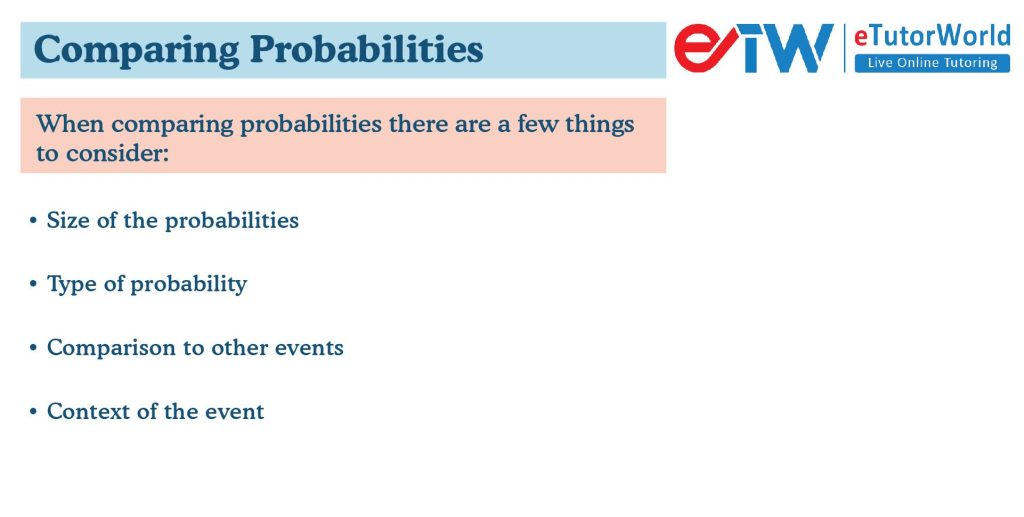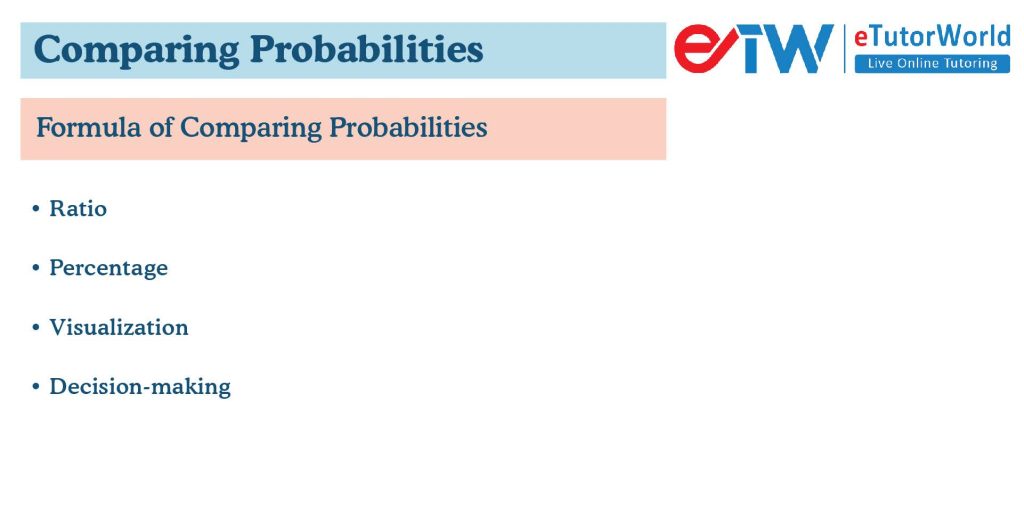Comparing Probabilities
Grade 7 Math Worksheets
- Comparing Probabilities
- The formula of Comparing Probabilities
- Example
- FAQs
Personalized Online Tutoring
Comparing Probabilities - Grade 7 Math Worksheet PDF
This is a free worksheet with practice problems and answers. You can also work on it online.
Sign up with your email ID to access this free worksheet.
"We really love eTutorWorld!"
"We really love etutorworld!. Anand S and Pooja are excellent math teachers and are quick to respond with requests to tutor on any math topic!" - Kieran Y (via TrustSpot.io)
"My daughter gets distracted easily"
"My daughter gets distracted very easily and Ms. Medini and other teachers were patient with her and redirected her back to the courses.
With the help of Etutorworld, my daughter has been now selected in the Gifted and Talented Program for the school district"
- Nivea Sharma (via TrustSpot.io)
Comparing Probabilities
When comparing probabilities, there are a few things to consider. Here are some key points to keep in mind:

Size of the probabilities: The size of the probabilities can give you an idea of how likely or unlikely an event is to occur. A probability of 0.5 means that the event is equally likely to occur as not to occur, while a probability of 0.9 means that the event is very likely to occur.
Type of probability: Theoretical and experimental probabilities can be compared, but they may not always be equal. Theoretical probabilities are based on mathematical calculations, while experimental probabilities are based on actual experimentation or observation. In some cases, the two may be very similar, while in others, they may be quite different.
Comparison to other events: It can be helpful to compare the probability of one event to the probability of another event. For example, if the probability of event A is 0.8 and the probability of event B is 0.2, event A is four times more likely to occur than event B.
Context of the event: The context of the event can also be important when comparing probabilities. For example, the probability of winning the lottery may be very small, but the potential payout may make it worth the risk for some people. On the other hand, the probability of getting sick from a particular food may be small, but the consequences could be serious.
Overall, when comparing probabilities, it is important to consider the size of the probabilities, the type of probability, the comparison to other events, and the context of the event.
Formula of Comparing Probabilities
There is no specific formula for comparing probabilities, as it generally involves analyzing and interpreting the probabilities in the context of the situation. However, there are some techniques and approaches that can be used to compare probabilities. Here are a few:

Ratio: One common way to compare probabilities is to take the ratio of the probabilities. For example, if the probability of event A is 0.8 and the probability of event B is 0.2, the ratio of the probabilities is 0.8 / 0.2 = 4. This means that event A is four times more likely to occur than event B.
Percentage: Another way to compare probabilities is to convert them to percentages. For example, a probability of 0.8 can be expressed as 80%, while a probability of 0.2 can be expressed as 20%. This can make it easier to compare the probabilities visually.
Visualization: Graphs and visual representations can be helpful for comparing probabilities. For example, a bar chart can be used to show the relative sizes of different probabilities. A pie chart can be used to show how different probabilities add up to 100%.
Decision-making: When comparing probabilities, it is often helpful to consider the decision-making context. For example, if the probability of winning the lottery is very small, but the potential payout is very large, some people may decide it is worth the risk. On the other hand, if the probability of a negative outcome is small, but the consequences are serious, some people may decide to take precautions to reduce the risk.
In general, comparing probabilities involves analyzing the probabilities in the context of the situation, and considering factors such as ratio, percentage, visualization, and decision-making.
“There have been times when we booked them last minute, but the teachers have been extremely well-prepared and the help desk at etutorworld is very prompt.
Our kid is doing much better with a higher score.”
7th Grade Tutoring
eTutorWorld offers Personalized Online Tutoring for Math, Science, English, and Standardised Tests.
Our Tutoring Packs start at just under $22.49 per hour, and come with a moneyback guarantee.
Schedule a FREE Trial Session, and experience quality tutoring for yourself. (No credit card required.)
Examples
Sure, here are some examples of comparing probabilities:
Ratio: Suppose the probability of rolling a 6 on a fair die is 1/6, the probability of rolling a 3 is ⅓ and the die is unfair. To compare these probabilities, we can take the ratio of 1/6 to 1/3, which is 1/2. This means that rolling a 3 is twice as likely as rolling a 6.
Percentage: Suppose the probability of it raining tomorrow is 0.6, and the probability of it being sunny is 0.4. To compare these probabilities, we can convert them to percentages. The probability of rain is 60%, while the probability of it being sunny is 40%.
Visualization: Suppose a class has 20 students, and the probability of a student being male is 0.6, while the probability of a student being female is 0.4. To compare these probabilities visually, we can create a bar chart with two bars, one for males and one for females, and label the heights of the bars with the probabilities.
Decision-making: Suppose a person is considering whether to invest in a stock with a 10% chance of a large return, or a bond with a 5% chance of a smaller return. To compare these probabilities, the person may consider the potential gains and risks of each option and make a decision based on their personal goals and preferences.
Do You Stack Up Against the Best?
If you have 30 minutes, try our free diagnostics test and assess your skills.
Comparing Probabilities FAQS
How do I compare theoretical and experimental probabilities?
Theoretical and experimental probabilities can be compared by analyzing the data and considering factors such as sample size, accuracy of measurement, and potential sources of bias. In general, if the experimental probabilities are close to the theoretical probabilities, this suggests that the theoretical model is a good approximation of reality.
How do I compare probabilities with different units of measurement?
If probabilities have different units of measurement, such as dollars, time, or distance, they can still be compared by converting them to a common unit of measurement. For example, if the probability of making a sale is $100 and the probability of saving $50 on a purchase is 0.5, we could convert the sale probability to a percentage (10%) and compare it to the probability of saving (50%).
How do I compare conditional probabilities?
Conditional probabilities are probabilities that are dependent on a particular condition or event. To compare conditional probabilities, it is important to consider the relationship between the conditions and events. For example, if the probability of getting a job offer is 0.5, but the probability of getting a job offer if you have a college degree is 0.8, we can compare the conditional probability of 0.8 to the unconditional probability of 0.5.
How do I compare probabilities with different types of events?
Probabilities of different types of events, such as discrete events (e.g., rolling a die) and continuous events (e.g., temperature measurements), cannot be compared directly. However, they can be analyzed and interpreted within their respective contexts.
How do I use probability to make decisions?
Probability can be a useful tool for making decisions, but it should be used in combination with other factors, such as personal goals, preferences, and risk tolerance. To use probability in decision-making, it is important to consider the potential outcomes, costs, and benefits of different options and weigh them against the associated probabilities.

Gloria Mathew writes on math topics for K-12. A trained writer and communicator, she makes math accessible and understandable to students at all levels. Her ability to explain complex math concepts with easy to understand examples helps students master math. LinkedIn
Affordable Tutoring Now Starts at Just $22.49
eTutorWorld offers affordable one-on-one live tutoring over the web for Grades K-12. We are also a leading provider of Test Prep help for Standardized Tests (SCAT, CogAT, MAP, SSAT, SAT, ACT, ISEE, and AP).
What makes eTutorWorld stand apart are: flexibility in lesson scheduling, quality of hand-picked tutors, assignment of tutors based on academic counseling and diagnostic tests of each student, and our 100% money-back guarantee.
Whether you have never tried personalized online tutoring before or are looking for better tutors and flexibility at an affordable price point, schedule a FREE TRIAL Session with us today.
*There is no purchase obligation or credit card requirement
Grade 7 Science Worksheets
- Elements and Compounds
- Solar Energy
- Photosynthesis
- Electricity and Magnetism
- Law of conservation of energy
- Periodic table
- Properties of Matter
- Waves
- Energy Resources
- Weather and Climate
- Immune, Circulatory and Digestive Systems
- Organs in Multi-cellular Organism
- Sedimentary, Igneous, and Metamorphic Rocks
- Structure of the Earth
- Law of Conservation of Mass
- Physical and Chemical Changes
- Scientific Method
- Human Digestive System
- Environmental Science
- Renewable and Non-renewable energy Resources
- Characteristics of Living Organisms
- Life Science
- Earth and Space Science
- Solar Eclipse
- Heat Technology
- Newton’s Laws of Motions
- Physical Science
- Tools, Measurement and SI Units
- Earth Atmosphere
- Interactions of Living things
- The Earth Ecosystem
- Organelles in Plant and Animal cells
- Layers of the Earth
- Cycles in Nature
Grade 7 Math Worksheets
- Fractions
- Linear equations word problems
- Statistics
- Properties of Parallel Line
- Finding slope from an equation
- Identifying Quadrilaterals
- Percent Change
- Properties of addition and multiplication
- Pythagorean Theorem
- Solving two step inequalities
- Symmetry
- Fractions to Decimals (New)
- Whole Number Exponents with Integer Bases (New)
- Adding and Subtracting Fractions (New)
- Integer Addition and Subtraction (New)
- Dividing Mixed Numbers (New)
- Basics of Coordinate Geometry (New)
IN THE NEWS

Our mission is to provide high quality online tutoring services, using state of the art Internet technology, to school students worldwide.
Online test prep and practice
SCAT
SSAT
ISEE
PSAT
SAT
ACT
AP Exam
Science Tutoring
Physics Tutoring
Chemistry Tutoring
Biology Tutoring
Math Tutoring
Pre-Algebra Tutoring
Algebra Tutoring
Pre Calculus Tutoring
Calculus Tutoring
Geometry Tutoring
Trigonometry Tutoring
Statistics Tutoring
Quick links
Free Worksheets
Fact sheet
Sales Partner Opportunities
Parents
Passive Fundraising
Virtual Fundraising
Our Expert Tutors
Safe and Secure Tutoring
Interactive Online Tutoring
After School Tutoring
Elementary School Tutoring
Middle School Tutoring
High School Tutoring
Home Work Help
Math Tutors New York City
Press
©2022 eTutorWorld Terms of use Privacy Policy Site by Little Red Bird
©2022 eTutorWorld
Terms of use
Privacy Policy
Site by Little Red Bird









